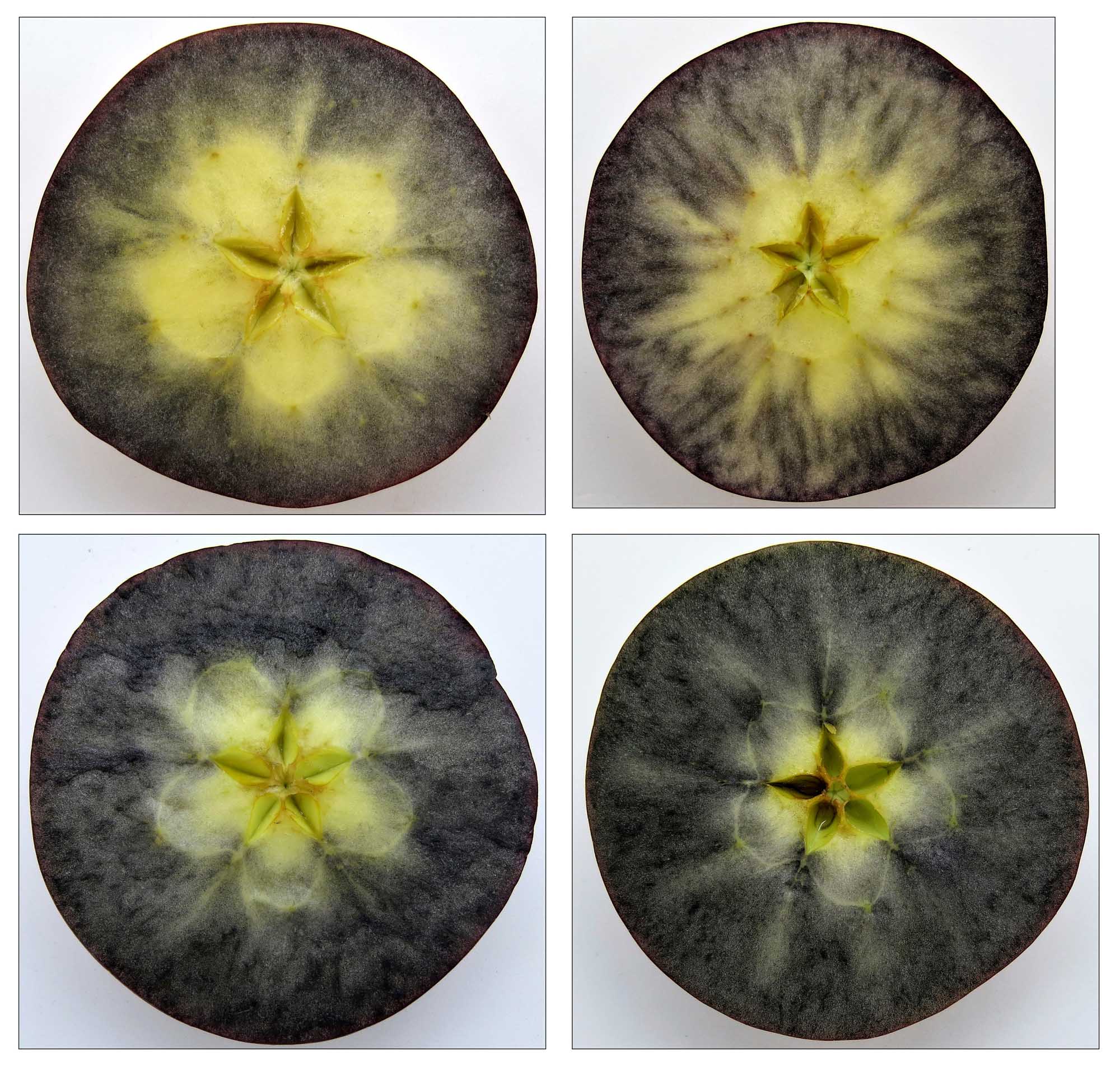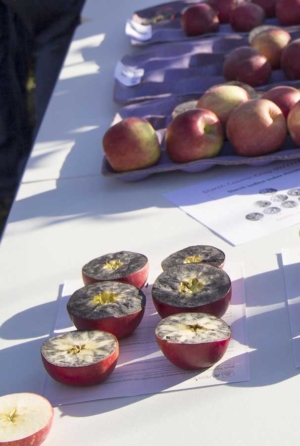
Researchers at the Washington Tree Fruit Research Commission are working to develop a starch scale for the new Washington State University-bred apple variety, WA 38, to be sold under the brand name Cosmic Crisp. In their first year of collecting samples of starch patterns typical for this variety, they found that starch clearing tends to show in two particular patterns: a flower pattern, seen in the two images on the left, or a radial pattern, with rays extending outward like the sun, in the two images on the right. (Photos courtesy of the Washington Tree Fruit Research Commission)
Researchers are working to develop a starch scale for the new Washington State University-bred apple variety WA 38, to be marketed and sold under the brand name Cosmic Crisp.
The first commercial trees were planted last spring and the variety is still at least a couple of years from production, but researchers at the Washington Tree Fruit Research Commission, in collaboration with a focus group of growers and scientists, have some early assessments following one year of study. They plan to continue the research in 2018.
“We want to look at every angle to give people as detailed information as possible so they can be prepared, especially since we are expecting the volume of fruit to ramp up fast,” WTFRC project manager Ines Hanrahan said. “We also want this information to be user friendly so people can easily make the correct decision when growing, harvesting and marketing this variety.”
More than 11 million trees are expected to be planted in the first three years, which will translate to a lot of fruit hitting the market at once. A grading subcommittee of the industry’s marketing advisory group for the apple’s retail rollout is establishing grading standards to enable the industry to be more flexible and meet changing needs of the market.
Grading standards will be key to ensuring consumers receive a high-quality piece of fruit each time. However, so will horticultural practices, and starch scales are one method to gauge the maturity of a piece of fruit.
Immature areas of a piece of fruit will turn a blue-black color when dipped in an iodine solution, indicating high starch levels, while parts of the apple where the starch has converted into sugars will be clear. Starch scales vary by region and by variety.
Cornell University provides Eastern U.S. growers with a scale range of one to eight, to point out eight different maturity levels; European growers use a scale that recognizes 10 maturity levels.
Washington growers traditionally recognize just six, and the researchers are continuing that tradition with WA 38.
The study
Researchers sampled fruit from the end of September through November, eventually sampling 638 apples from four research orchards.
They cut apples in half through the equator (the core for WA 38 is located farther down the apple than most varieties, and the cut to determine starch levels should be made through the core).
Then they dipped the slices in an iodine solution and waited up to 30 minutes to determine starch levels for fruit at room temperature; for cold fruit, starch patterns sometimes took up to an hour to fully develop.
They then photographed the results to begin to develop a scale.

Researchers from Washington State University and the Washington Tree Fruit Research Commission share the latest findings into growing the new WSU apple variety, WA 38, also known as Cosmic Crisp, at a field day at WSU’s Sunrise Orchard west of Quincy, Washington on Sept. 27, 2017. (Shannon Dininny/Good Fruit Grower)
Typically, starch clears out of an apple’s core area first, followed by degrees of clearing in the apple cortex, but WA 38 did not show that natural tendency, said Felix Schuhmann, a WTFRC research assistant. In addition, it became clear that darkening of apple flesh after application of the iodine solution to visualize remaining starch takes longer than with other varieties.
Hanrahan noted that it’s a point growers should be aware of, especially if they intend to perform starch readings in the field. Some varieties show fully developed starch patterns within a minute, while WA 38 will require at least 5 minutes, and up to half an hour if the fruit is cold (like on a cool fall morning).
So far, they’ve seen such slow disappearance of starch levels that they’ve developed a pilot half-scale (1.5, 2, 2.5). In addition, they’ve seen two patterns for how starches appear in fruit from the same tree: a flower pattern, which is most dominant and found in about 60 percent of the fruit, and a radial pattern that sprays outward like the sun’s rays.
In the year ahead, the researchers are focusing on three key areas to tweak the scale:
—The researchers struggled to find stage five fruit picked straight from the tree, which means starches are moving very slowly out of the apple before harvest. That’s good news in terms of long-term storability of WA 38, but they intend to let some fruit hang longer to determine just how long the period is to reach stage five or six on the tree. “We didn’t let fruit hang on the tree long enough to determine when the fruit reaches that stage naturally,” Schuhmann said. “We have to assess how long that actually takes during the season.” On average, research on WA 38 has shown growers will have a two-week harvest window for controlled atmosphere storage-quality fruit.
—Instead of just conducting horizontal cuts, the researchers also intend to perform vertical cuts to show starch clearance differences between the core area and the calyx and stem bowl area, which might be helpful to determine if fruit is prone to splitting, Hanrahan said.
—Schuhmann said the researchers also aim to compare starch clearance rates to the rates of other common apple varieties.
The research is being funded by the Washington Tree Fruit Research Commission. •
—by Shannon Dininny






Leave A Comment